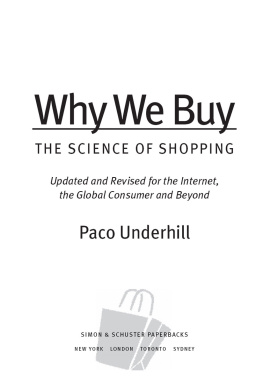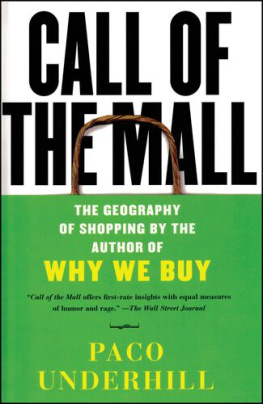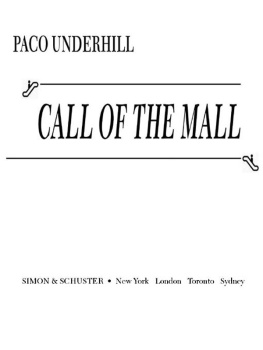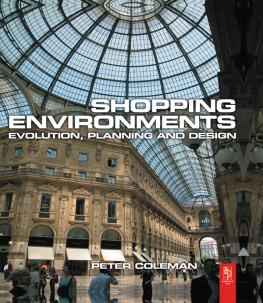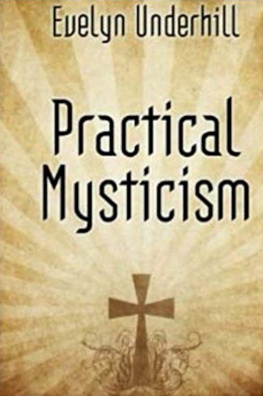Praise For
Paco Underhill
and
Why We Buy
The Dalai Lama said, Shopping is the museum of the twentieth century. Paco Underhill explains why. Brilliantly.
Faith Popcorn, author and Future Forecaster
Why We Buy is useful as a how-to for retailers, but shoppers will discover a Vance Packard for our times, on the trail of our centurys hidden persuaders.
Hardy Green, BusinessWeek
For retailers, this book should be mandatory. For the rest of us, its just plain fun.
Harvey Schachter, The Globe and Mail (Toronto)
No matter which point of view youre coming from, shopper or shopkeeper, youll find Underhills tips are often funny, sometimes provocative, and almost always usable.
The San Diego Union-Tribune
What Underhill offers in this delightful and engrossing book is a primer in the science of shoppingThe effect of reading this book is that of being alternately entertained by hilarious stories and enlightened by trenchant observations.
Newsday
Underhills way of looking at how we shop may revolutionize the industry. In this day of heavy competition, advice from this book could give a retailer the edge needed to survive. This book provides an excellent method for retailers to examine their own store space and look for what may draw customers in, as well as what may be causing them to leave without buying.
Teresa McUsic, Star-Telegram (Fort Worth)
The guru of retail consulting offers a wealth of insight into what makes a successful shopping experience for both buyer and seller.
Craig Ryan, The Oregonian
A fascinating voyage through the mall that will open your eyes to the psychology of modern retailingand especially to the new dynamics of consumer shopping.
G. William Gray, The Tampa Tribune
Ostensibly a business book aimed at merchandisers, Why We Buy will also appeal to consumers who want to understand the art of shopping and the science of selling.
Justin Adams, MSNBC
Paco Underhill is Sherlock Holmes for retailersThis sleuth makes shoppers view stores with more critical eyes.
Trish Donnally, San Francisco Chronicle
A remarkable business tool, a distillation of all those notes and tapes, packaged in a way that is useful, witty, and loving.
Keith H. Hammonds, Fast Company
A readable, entertaining study of the behavioral science of shopping.
Adrienne Miller, Esquire
Intriguing for both lovers and haters of the game of visual stimulation.
Booklist
This lighthearted look at shopping is highly recommended to anyone who buys or sells.
Rob McDonald, Amazon.com

ALSO BY PACO UNDERHILL
Call of the Mall

Simon & Schuster
A Division of Simon & Schuster, Inc.
1230 Avenue of the Americas
New York, NY 10020
Copyright 1999, 2000, 2009 by Obat, Inc.
All rights reserved, including the right to reproduce this book or portions thereof in any form whatsoever. For information, address Simon & Schuster Subsidiary Rights Department, 1230 Avenue of the Americas, New York, NY 10020.
SIMON & SCHUSTER and colophon are registered trademarks of Simon & Schuster, Inc.
The Library of Congress has cataloged the hardcover as follows: Underhill, Paco.
Why we buy: the science of shopping / Paco Underhill.
p. cm.
1. Marketing research. 2. Consumer behavior. 3. Shopping. I Title.
HF5415.2.U53 1999
658.834dc21 99-12125
CIP
ISBN-13: 978-1-4165-6174-3
ISBN-10: 1-4165-6174-9
Visit us on the World Wide Web:
http://www.SimonSays.com
DEDICATION
Who knew when the first keystrokes of this document were made in the spring of 1997 that ten years and twenty-seven foreign translations later this book would still be alive? I am grateful that in the summer of 1999, when this book came out, my father, Francis Underhill, got to see it. I dont think he really knew what I did even after reading it. He had a lot of interests, but shopping wasnt ever among them. He died that fall. I was there. I made him a martini and helped him get comfortable in bed. He went, sleeping next to my mother, his wife of more than fifty years. I still talk to him.
AUTHORS NOTE
For some of you, the book you hold in your hands may be an old friendgiven as a gift, bought in an airport, secured through Amazon or assigned at a school or training progam. Thanks for picking it up again. Most volumes stocked in the business section of a bookstore have a short shelf life. They zoom and crash and are forgotten within a year. This book has lasted ten years and is available in twenty-seven foreign editions. I had no idea when pen first went to paper back in 1997 that my story would appeal to so many readers.
From Russia to Japan, from Spain to Thailand, Ive had visits and e-mails from readers just wanting to say hi, many looking for a job and not a few telling me their own stories. University professors from China, a Marxist minister in the Bengali provincial government, a jewelry designer from Spainthe list goes on. My favorite pieces of correspondence came from a man who ran a septic tank cleaning business in Missouri. The letter was handwritten on lined paper. I dont know how many letters that man writes a year, but I know I was privileged to get one of them. Hed read the book and wanted my advice on what color to paint his truck.
In 2007, I reread Why We Buy and realized that parts of the story had progressed and that some of the examples Id used were dated. The book needed freshening and thats what its gotten. If you liked it the first time, youll like it even better the second. If youre picking it up for the first time, whether you love or hate shopping, this is a good, entertaining read, and youll never look at the world of shopping and consumption the same way again.
Paco Underhill
January 2009
CONTENTS
I
INSTEAD OF SAMOA, STORES:
THE SCIENCE OF SHOPPING
II
WALK LIKE AN EGYPTIAN:
THE MECHANICS OF SHOPPING
III
MEN ARE FROM HOME DEPOT,
WOMEN ARE FROM BLOOMINGDALES:
THE DEMOGRAPHICS OF SHOPPING
IV
SEE ME, FEEL ME, TOUCH ME, BUY ME:
THE DYNAMICS OF SHOPPING
V SCREEN SAVERS, JET LAG AND WHIRLING DERVISHES:
THE CULTURE OF SHOPPING
I
Instead of Samoa, Stores: The Science of Shopping
O kay, stroll, stroll, stroll stop.
Shhh. Stay behind that potted palm. Get out your clipboard and pen.
Our subject is the fortyish woman in the tan trench coat and blue skirt. Shes in the bath section. Shes touching towels. Mark this downshes petting one, two, three, four of them so far. She just checked the price tag on one. Mark that down, too. Carefuldont get too closeyou dont want her to see you. She picked up two towels from the tabletop display and is leaving the section with them. Mark the time. Now, tail her into the aisle and on to her next stop.
Thus begins another day in the vineyards of science, specifically the science of shopping. But lets start by addressing a fundamental question: Since when does such a scholarly discipline even exist?
Well, if, say, anthropology had devoted a branch of itself to the study of shoppers in situ (a fancy Latin way of saying shoppers out shopping), interacting with retail environments (stores, but also banks and restaurants), the actual, physical premises, including but not limited to every rack, shelf, counter and table display of merchandise, every sign, banner, brochure, directional aid and computerized interactive informational fixture, the entrances and exits, the windows and walls, the elevators and escalators and stairs and ramps, the cashier lines and teller lines and counter lines and restroom lines, and every inch of every aislein short, every nook and cranny from the farthest reach of the parking lot to the deepest penetration of the store itself, if anthropology had already been studying all thatand not simply studying the store, of course, but what, exactly and preciselyscientificallyhuman beings do in it, where they go and dont go, and by what path they go there; what they see and fail to see, or read and decline to read; and how they deal with the objects they come upon, how they shop, you might saythe precise anatomical mechanics and behavioral psychology of how they pull a sweater from a rack to examine it, or read a box of heartburn pills or a fast-food restaurant menu, or grab a shopping basket, or react to the sight of a line at the ATMsagain, as I say, if anthropology had been paying attention, and not just paying attention but then collecting, collating, digesting, tabulating and cross-referencing every little bit of data, from the extremely broad (How many people enter this store on a typical Saturday morning, broken down by age, sex and size of shopper group?) to the extremely narrow (Do more male supermarket shoppers under thirty-five who read the nutritional information on the side panel of a cereal box actually buy the cereal compared to those who just look at the picture on the front?), well, then, we wouldnt have had to invent the science of shopping. In 1997, when this volume was originally written, the academic world knew more about the marketplace in Papua New Guinea than what happened at your local supermarket or shopping mall. Twentieth-century anthropology wasnt about what happened in your backyard.

